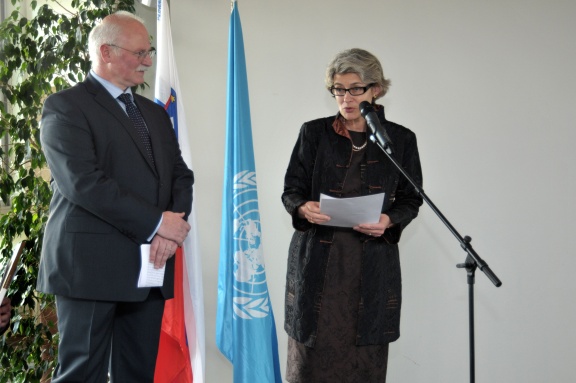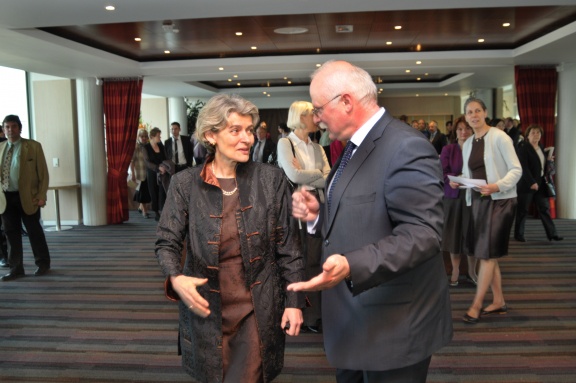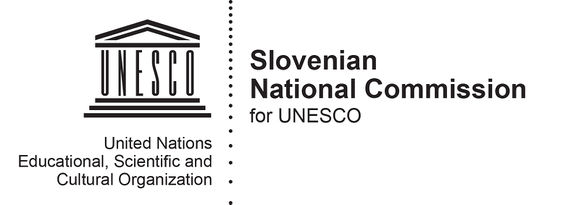Difference between revisions of "Slovenia National Commission for UNESCO"
(contact change) |
|||
| Line 7: | Line 7: | ||
| localname = Slovenska nacionalna komisija za UNESCO | | localname = Slovenska nacionalna komisija za UNESCO | ||
| logo = Slovenia National Commission for UNESCO (logo).jpg | | logo = Slovenia National Commission for UNESCO (logo).jpg | ||
| − | | street = | + | | street = Masarykova cesta 16 |
| town = SI-1000 Ljubljana | | town = SI-1000 Ljubljana | ||
| map = http://www.openstreetmap.org/?lon=14.51388&lat=46.05674&zoom=17&layer=mapnik | | map = http://www.openstreetmap.org/?lon=14.51388&lat=46.05674&zoom=17&layer=mapnik | ||
| Line 13: | Line 13: | ||
| fax = 386 (0) 1 478 4660 | | fax = 386 (0) 1 478 4660 | ||
| email = unesco.mizs@gov.si | | email = unesco.mizs@gov.si | ||
| − | | website = https://www.gov.si/ | + | | website = https://www.gov.si/drzavni-organi/ministrstva/ministrstvo-za-izobrazevanje-znanost-in-sport/o-ministrstvu/urad-za-unesco/ |
| managed by = United Nations Educational, Scientific and Cultural Organisation (UNESCO) | | managed by = United Nations Educational, Scientific and Cultural Organisation (UNESCO) | ||
| managed by 2 = Ministry of Education, Science and Sport | | managed by 2 = Ministry of Education, Science and Sport | ||
| contacts = {{Contact | | contacts = {{Contact | ||
| − | | name = | + | | name = Irena Mlinarič Raščan |
| − | | role = | + | | role = President |
| − | | telephone = 386 (0) 1 478 | + | | telephone = |
| − | | email = | + | | email = |
| + | }}{{Contact | ||
| + | | name = Gašper Hrastelj | ||
| + | | role = Secretary General | ||
| + | | telephone = 386 (0) 1 478 4678 | ||
| + | | email = | ||
}} | }} | ||
}} | }} | ||
| Line 84: | Line 89: | ||
== External links == | == External links == | ||
* [https://www.gov.si/en/state-authorities/ministries/ministry-of-education-science-and-sport/about-us/urad-za-unesco/ UNESCO Office web page on the Gov.si website] | * [https://www.gov.si/en/state-authorities/ministries/ministry-of-education-science-and-sport/about-us/urad-za-unesco/ UNESCO Office web page on the Gov.si website] | ||
| − | * [ | + | * [https://www.slovenia.info/en/places-to-go/attractions/unesco-world-heritage About the UNESCO sites on Slovenia.info] |
| − | |||
| − | |||
{{gallery}} | {{gallery}} | ||
Revision as of 08:35, 29 July 2021
Educational programmes
The Slovenia National Commission for UNESCO has been actively participating in UNESCO's educational programmes which have a broader, more basic and global scope providing for lifelong learning and 'education for all'. The Associated Schools Project Network (ASP) is active within the framework of the commission and includes 29 institutions, among them 18 elementary schools and nine secondary schools. The schools take part in international projects and every year a one-week international meeting is held in Piran. A brochure has been published by UNESCO and sent to all the countries.
World Heritage programmes
The commission is also active in the field of heritage programmes, i.e. the UNESCO World Heritage sites in Slovenia. The Škocjan Caves, one of the most famous sites in the world for the study of karst (limestone) phenomena, was inscribed on the UNESCO World Heritage List in 1986. In 2010 the two remains of prehistoric pile dwellings from the Ljubljansko Barje marshlands were selected to become part of the transnational heritage site "Prehistoric Pile Dwellings around the Alps". The next additions were the Heritage of Mercury. Almadén and Idrija in 2012, and the "Ancient and Primeval Beech Forests of the Carpathians and Other Regions of Europe" (including the two forest reserves, Krokar and Snežnik – Ždrocle Virgin Forests in Notranjska Region, inscribed in 2017. The latest inscription "The works of Jože Plečnik in Ljubljana – Human Centred Urban Design" was added onto the list in 2021.
UNESCO’s Tentative List, which is a required stage of the nomination process, currently has four Slovenian entries – Classical Karst since 1994 and 2015, the Fužina Hills in Bohinj since 1994, the Franja Partisan Hospital since 2000 (European Heritage Label 2015), and the Walk of Peace from the Alps to the Adriatic – Heritage of the First World War, a 230 kilometres long trail along the former WWI Isonzo front that was also put on the tentative list in February 2016.
Sites on the tentative list
- The Fužina Hills in Bohinj (added in 1994), are part of Triglav National Park and are unique for alpine herding on high pastures with special farm structures primarily hayracks named Kozolec in Slovene and also types of pasture cottages where milk and diary products are made. People's customs and festivities are of ethnological importance and are connected with high mountain herding.
- The Classic Karst (added in 2015), region in western Slovenia named Kras where the term Karst originated. It is limestone plateau known for various karst phenomena such as caves, abysses, sinkholes and intermittent lakes.
- The Franja Partisan Hospital (added in 2000) is Second World War hospital comprised of 13 wooden buildings. Complex was set up in the period from December 1943 to May 1945 and was among the best equipped clandestine partisan hospitals with an operating room, X-ray apparatus, an invalid care facility, and a small electric plant.
- The beech forests in the Notranjska region as an outstanding example of undisturbed, complex temperate forests, are an extension to the Joint World Heritage Property Primeval Beech Forests of the Carpathians (Slovak Republic and Ukraine) and Ancient Beech Forest of Germany, added in January 2015.
- The Czech Republic initiated the nomination of the The timeless, humanistic architecture of Jože Plečnik in Ljubljana and Prague for the inscription of on the UNESCO World Heritage List. Added in January 2015.
- The Walk of Peace from the Alps to the Adriatic – Heritage of the First World War covers the area of the Isonzo Front with many important monuments and ruins, including military cemeteries, air-raid cavern shelters, ditches, ossuaries, chapels, monuments, outdoor museums and other historic elements. Added in 2016.
List of Intangible Cultural Heritage
The Škofja Loka Passion Play was inscribed on the Representative List of the Intangible Cultural Heritage of Humanity in 2016. In 2017 the next inscription follows: the Door-to-door rounds of Kurenti, a Shrovetide custom practised through villages and the town of Ptuj. The Bobbin LaceMaking and the Art of dry stone walling, knowledge and techniques (Croatia, Cyprus, France, Greece, Italy, Slovenia, Spain and Switzerland) was inscribed onto the List in 2018.
Communication and Information programmes
In November 2011 the Institute of Information Sciences (IZUM) was granted a status of the Regional Centre for Library Information Systems and Current Research Information Systems (IZUM) as a UNESCO Category 2 centre. In September 2012 the agreement was signed in Paris.
Funding
In 2010 Municipality of Ljubljana took over the prestigious World Book Capital UNESCO title.
Alongside the celebrations in 2008 of the 500th anniversary of the birth of Primož Trubar, the founder of the literary Slovenian language and leader of the Protestant Reformation movement in Slovenia, the National Commission included his birthday on the world's anniversaries list.
UNESCO also supported the Crossradio multicultural radio station network (2001–2009), which included Radio Študent (RŠ) and Mariborski radio Študent (MARŠ) from Slovenia along with independent radio stations from Banja Luka, Belgrade, Mostar, Novi Sad, Sarajevo, Sombor, Skopje, Zrenjanin, Zurich, and Basel. Each week one of these stations contributed a half-hour programme which was broadcast by all members of the network. The aim of the project was to help reduce distrust and tension between the different cultures in South-east Europe, to encourage cultural dialogue and to promote the plurality of media while supporting freedom of expression.
About UNESCO
The United Nations Educational, Scientific and Cultural Organisation (UNESCO) seeks to encourage the identification, protection and preservation of cultural and natural heritage around the world considered to be of outstanding value to humanity. This is embodied in an international treaty called the Convention Concerning the Protection of the World Cultural and Natural Heritage, adopted by UNESCO in 1972. What makes the concept of World Heritage exceptional is its universal application. World Heritage sites belong to all the peoples of the world, irrespective of the territory on which they are located.
UNESCO has a National Commission in each Member State, comprising eminent members of the intellectual and scientific communities and forming the essential link between those communities and UNESCO, helping each Member States to take maximum advantage of their adhesion to the organisation. Slovenia joined UNESCO on 27 May 1992 and formed Slovenia National Commission for UNESCO.
See also
- UNESCO World Heritage Sites in Slovenia
- Škocjan Caves World Heritage Site
- Franja Partisan Hospital
- Idrija Municipal Museum
- Triglav National Park
- Walk of Peace in the Soča Region Foundation
- Škofja Loka Passion Play
- Kurentovanje
- Ministry of Education, Science and Sport






